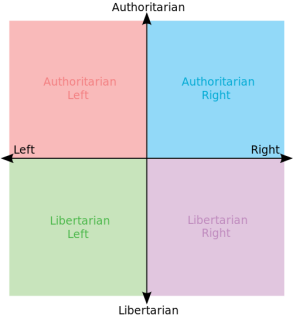One of the problems with ideology, other than its definition, is how do we measure it? By many definitions ideologies are subjective belief systems and, much like human behavior in general, belief systems can vary quite a lot. Likewise when people use political ideologies to translate those beliefs into governance it creates a vast array of different kinds of systems.

Out of this confusion then, is there some kind of metric by which we can measure ideology? The answer political science has given us so far is the traditional left-right scale. On this scale, the left consists of economic redistribution along with liberal social attitudes while on the right is protection of private property.
Of course this scale has major problems. Theoretically, a country like the Soviet Union was arguably as “left-wing” as free communes like the Kibbutz in Israel or syndicalist workplaces in Spain. Likewise there can be dictatorships like Pinochet in Chile who are just as “right-wing” in terms of property (if not more so) as societies with democracy and human rights. This gives us a dilemma; do these extremes simply overlap on the scale?
The solution to this problem has been to add a second dimension on the scale, one of authority. Thus it is both based on economic cooperation or individualism, as well as deference to authority figures. The political compass is designed to measure ideology in four quadrants: Authoritarian Right, Authoritarian Left, Libertarian Right and Libertarian Left so as to give a better distinction as to how different people and ideologies might fall on the map.

So does this solve the problem of how to map ideology? My impression is that while it is the best metric we have so far, it still does not solve the problem for the foundations of those belief systems. We may understand ideologies in terms of those two dimensions, but we have little understanding for why people get those two dimensions (or even what kind of “coordinates” or symbols people use to cognitively get to those dimensions). Ideally, we will have an adequate measure when we know what those coordinates are and can experimentally determine that having those coordinates will lead to those dimensions.
 This brings us to my political ideology. As it stands on the scale I’m in the Libertarian Left or what I suppose is a modern liberal in the American sense. Although this position might seem typical for a college student it is relatively uncommon in the American political system. As such, it has helped me see that many distinctions in political ideology like freedom of the individual vs. collectivism are generally false dichotomies (in this case because one has freedom to the extent they don’t take freedom away from someone else, the question then is what constitutes “freedom”). Ultimately, I think my stance has helped to see some of the problems with the current definitions.
This brings us to my political ideology. As it stands on the scale I’m in the Libertarian Left or what I suppose is a modern liberal in the American sense. Although this position might seem typical for a college student it is relatively uncommon in the American political system. As such, it has helped me see that many distinctions in political ideology like freedom of the individual vs. collectivism are generally false dichotomies (in this case because one has freedom to the extent they don’t take freedom away from someone else, the question then is what constitutes “freedom”). Ultimately, I think my stance has helped to see some of the problems with the current definitions.